Machine Learning Applications in Optical Fiber Sensing: A Research Agenda
Abstract
1. Introduction
- RQ1: What is the historical evolution of scientific literature on machine learning applications in fiber optic sensors?
- RQ2: What are the primary research sources for machine learning applications in fiber optic sensors?
- RQ3: What is the thematic evolution of machine learning applications in fiber optic sensors?
- RQ4: What are the primary themes in using machine learning for fiber optic sensor applications?
- RQ5: What are the established and emerging keywords in the research field of machine learning applications in fiber optic sensors?
- RQ6: What topics are relevant for designing a research agenda on machine learning applications in fiber optic sensors?
2. Materials and Methods
2.1. Eligibility Criteria
2.2. Information Sources
2.3. Search Strategy
2.4. Data Management
2.5. Selection Process
3. Results
4. Discussion
4.1. Analysis of Thematic Evolution
4.2. Analysis of Keyword Co-Occurrence
4.3. Analysis of Emerging Words
4.4. Classification of Keywords
4.5. Research Agenda
4.6. Limitations
5. Conclusions
Author Contributions
Funding
Data Availability Statement
Conflicts of Interest
Abbreviations
| RQ | Research question |
| 3-D FRP-FBG | fiber optic Bragg grating sensors reinforced with glass fibers |
| DAS | Distributed acoustic sensor |
| ANN | Artificial neutral network |
| LSTM | Long short-term memory |
| HUMS | Health and usage monitoring system |
| UAV | Unmanned aerial vehicle |
| FBG | Fiber Bragg gratings |
| ML | Machine learning |
| BP | Blood pressure |
| PPG | Photoplethysmogram |
| CNN | Convolutional neural network |
| EEG | Electroencephalogram |
| DLW | Direct laser writing |
| FEM | Finite element method |
| WDM | Wavelength division multiplexing |
| AI | Artificial intelligence |
| SVM | Support vector machines |
| SVDD | Support vector data description |
| BOTDA | Brillouin optical time domain analyzer |
| φ-OTDR | phase-sensitive optical time-domain reflectometry |
| PCF | photonic crystal fibers |
| RNN | recurrent neural networks |
| LVAD | Left ventricular assist devices |
| WSN | Wireless sensor network |
| PIP | Pipe-in-pipe |
| DTS | Distributed temperature sensing |
References
- Leal-Junior, A.G.; Frizera, A.; Marques, C.; Pontes, M.J. Optical Fiber Specklegram Sensors for Mechanical Measurements: A Review. IEEE Sens. J. 2020, 20, 569–576. [Google Scholar] [CrossRef]
- Bellavia, D.; Iacovoni, A.; Agnese, V.; Falletta, C.; Coronnello, C.; Pasta, S.; Novo, G.; di Gesaro, G.; Senni, M.; Maalouf, J.; et al. Usefulness of regional right ventricular and right atrial strain for prediction of early and late right ventricular failure following a left ventricular assist device implant: A machine learning approach. Int. J. Artif. Organs 2020, 43, 297–314. [Google Scholar] [CrossRef]
- Liu, G.; Meng, H.; Qu, G.; Wang, L.; Ren, L.; Lu, H. Real-time monitoring and prediction method of commercial building fire temperature field based on distributed optical fiber sensor temperature measurement system. J. Build. Eng. 2023, 70, 106403. [Google Scholar] [CrossRef]
- Xu, W. Optical sensor based quantum computing in sports medicine for diagnosis and data analysis using machine learning model. Opt. Quantum Electron. 2024, 56, 528. [Google Scholar] [CrossRef]
- Boucek, K.; Alzubi, A.; Zafar, F.; O’connor, M.J.; Mehegan, M.; Mokshagundam, D.; Davies, R.R.; Adachi, I.; Lorts, A.; Rosenthal, D.N. Taking ACTION: A Prognostic Tool for Pediatric Ventricular Assist Device Mortality. ASAIO J. 2023, 69, 602–609. [Google Scholar] [CrossRef]
- Liu, G.; Meng, H.; Qu, G.; Wang, L.; Ren, L.; Fang, L. Distributed optical fiber sensor temperature dynamic correction method based on building fire temperature-time curve. J. Build. Eng. 2023, 68, 106050. [Google Scholar] [CrossRef]
- Feng, H.; Wang, M.; Sha, Z.; Du, L.; Qi, D. Research on Weak Vibration Characteristics Based on EMD and Design of MZI Classifier. J. Light. Technol. 2023, 41, 3182–3191. [Google Scholar] [CrossRef]
- Zhu, C.; Alsalman, O.; Naku, W. Machine learning for a Vernier-effect-based optical fiber sensor. Opt. Lett. 2023, 48, 2488–2491. [Google Scholar] [CrossRef]
- Karapanagiotis, C.; Hicke, K.; Krebber, K. A collection of machine learning assisted distributed fiber optic sensors for infrastructure monitoring. TM-Tech. Mess. 2023, 90, 177–195. [Google Scholar] [CrossRef]
- Naku, W.; Nambisan, A.K.; Roman, M.; Zhu, C.; Gerald, R.E.; Huang, J. Identification of Volatile Organic Liquids by Combining an Array of Fiber-Optic Sensors and Machine Learning. ACS Omega 2023, 8, 4597–4607. [Google Scholar] [CrossRef]
- Dwivedi, Y.S.; Singh, R.; Sharma, A.K.; Sharma, A.K. Enhancing the Performance of Photonic Sensor Using Machine-Learning Approach. IEEE Sensors J. 2023, 23, 2320–2327. [Google Scholar] [CrossRef]
- Hassani-Marand, M.; Fahimi-Kashani, N.; Hormozi-Nezhad, M.R. Machine-learning assisted multiplex detection of catecholamine neurotransmitters with a colorimetric sensor array. Anal. Methods 2023, 15, 1123–1134. [Google Scholar] [CrossRef]
- Schletz, D.; Breidung, M.; Fery, A. Validating and Utilizing Machine Learning Methods to Investigate the Impacts of Synthesis Parameters in Gold Nanoparticle Synthesis. J. Phys. Chem. C 2023, 127, 1117–1125. [Google Scholar] [CrossRef]
- Wellbrock, G.A.; Xia, T.J.; Huang, M.-F.; Han, S.; Chen, Y.; Wang, T.; Aono, Y. Explore Benefits of Distributed Fiber Optic Sensing for Optical Network Service Providers. J. Light. Technol. 2023, 41, 3758–3766. [Google Scholar] [CrossRef]
- Li, S. Quantum photonics based music signal analysis with optical sensor in health monitoring using machine learning model. Opt. Quantum Electron. 2024, 56, 580. [Google Scholar] [CrossRef]
- Zhou, C.; Huang, C.; Zhang, H.; Yang, W.; Jiang, F.; Chen, G.; Liu, S.; Chen, Y. Machine-learning-driven optical immunosensor based on microspheres-encoded signal transduction for the rapid and multiplexed detection of antibiotics in milk. Food Chem. 2023, 437, 137740. [Google Scholar] [CrossRef]
- Zhan, K.; Jiang, Y.; Qin, P.; Chen, Y.; Heinke, L. A Colorimetric Label-Free Sensor Array of Metal–Organic-Framework-Based Fabry–Pérot Films for Detecting Volatile Organic Compounds and Food Spoilage. Adv. Mater. Interfaces 2023, 10, 2300329. [Google Scholar] [CrossRef]
- Thompson, A.J.; Power, M.; Yang, G.-Z. Micro-scale fiber-optic force sensor fabricated using direct laser writing and calibrated using machine learning. Opt. Express 2018, 26, 14186–14200. [Google Scholar] [CrossRef]
- Zhu, C.; Huang, J. Self-Vernier Effect-Assisted Optical Fiber Sensor Based on Microwave Photonics and Its Machine Learning Analysis. J. Light. Technol. 2023, 41, 1890–1898. [Google Scholar] [CrossRef]
- Monsberger, C.M.; Bauer, P.; Buchmayer, F.; Lienhart, W. Large-scale distributed fiber optic sensing network for short and long-term integrity monitoring of tunnel linings. J. Civ. Struct. Health Monit. 2022, 12, 1317–1327. [Google Scholar] [CrossRef]
- Kusche, N.; Schukar, V.; Hofmann, D.; Basedau, F.; Habel, W.; Woschitz, H.; Lienhart, W. Field examples for optical fibre sensor condition diagnostics based on distributed fibre optic strain sensing. In Proceedings of the Fifth European Workshop on Optical Fibre Sensors, Kraków, Poland, 19–22 May 2013; p. 87943. [Google Scholar]
- Karapanagiotis, C.; Hicke, K.; Wosniok, A.; Krebber, K. Distributed humidity fiber-optic sensor based on BOFDA using a simple machine learning approach. Opt. Express 2022, 30, 12484–12494. [Google Scholar] [CrossRef]
- Qin, Z.; Qu, S.; Wang, Z.; Yang, W.; Li, S.; Liu, Z.; Xu, Y. A fully distributed fiber optic sensor for simultaneous relative humidity and temperature measurement with polyimide-coated polarization maintaining fiber. Sensors Actuators B Chem. 2022, 373, 132699. [Google Scholar] [CrossRef]
- Stajanca, P.; Hicke, K.; Krebber, K. Distributed Fiberoptic Sensor for Simultaneous Humidity and Temperature Monitoring Based on Polyimide-Coated Optical Fibers. Sensors 2019, 19, 5279. [Google Scholar] [CrossRef]
- Thomas, P.J.; Hellevang, J.O. A fully distributed fibre optic sensor for relative humidity measurements. Sensors Actuators B Chem. 2017, 247, 284–289. [Google Scholar] [CrossRef]
- He, C.; Korposh, S.; Correia, R.; Liu, L.; Hayes-Gill, B.R.; Morgan, S.P. Optical fibre sensor for simultaneous temperature and relative humidity measurement: Towards absolute humidity evaluation. Sensors Actuators B Chem. 2021, 344, 130154. [Google Scholar] [CrossRef]
- Lu, X.; Hicke, K.; Breithaupt, M.; Strangfeld, C. Distributed Humidity Sensing in Concrete Based on Polymer Optical Fiber. Polymers 2021, 13, 3755. [Google Scholar] [CrossRef] [PubMed]
- Wosniok, A.; Sporea, D.; Neguţ, D.; Krebber, K. Gamma radiation influence on silica optical fibers measured by optical backscatter reflectometry and Brillouin sensing technique. In Proceedings of the Sixth European Workshop on Optical Fibre Sensors, Limerick, Ireland, 31 May–3 June 2016; pp. 358–361. [Google Scholar]
- Stajanca, P.; Krebber, K. Radiation-Induced Attenuation of Perfluorinated Polymer Optical Fibers for Radiation Monitoring. Sensors 2017, 17, 1959. [Google Scholar] [CrossRef]
- Stajanca, P.; Mihai, L.; Sporea, D.; Neguţ, D.; Sturm, H.; Schukar, M.; Krebber, K. Effects of gamma radiation on perfluorinated polymer optical fibers. Opt. Mater. 2016, 58, 226–233. [Google Scholar] [CrossRef]
- Rizzolo, S.; Boukenter, A.; Ouerdane, Y.; Michalon, J.-Y.; Marin, E.; Macé, J.-R.; Girard, S. Distributed and discrete hydrogen monitoring through optical fiber sensors based on optical frequency domain reflectometry. J. Phys. Photon. 2020, 2, 014009. [Google Scholar] [CrossRef]
- Lin, Y.; Liu, F.; He, X.; Jin, W.; Zhang, M.; Yang, F.; Ho, H.L.; Tan, Y.; Gu, L. Distributed gas sensing with optical fibre photothermal interferometry. Opt. Express 2017, 25, 31568–31585. [Google Scholar] [CrossRef]
- López, E.S.; Quintero, S.J.C.; Fernández, H.; Magdalena, M.; Rodríguez, L.; Juana, I. Bibliometry, an eficcient to assess the postgraduate scientific activity. Medisur 2009, 7, 291–294. [Google Scholar]
- Araújo Ruiz, J.A.; Arencibia Jorge, R. Informetría, bibliometría y cienciometría: Aspectos teórico-prácticos. Acimed 2002, 10, 5–6. [Google Scholar]
- Page, M.J.; McKenzie, J.E.; Bossuyt, P.M.; Boutron, I.; Hoffmann, T.C.; Mulrow, C.D.; Shamseer, L.; Tetzlaff, J.M.; Akl, E.A.; Brennan, S.E.; et al. The PRISMA 2020 statement: An updated guideline for reporting systematic reviews. Syst. Rev. 2021, 10, 105906. [Google Scholar] [CrossRef] [PubMed]
- Singh, V.K.; Singh, P.; Karmakar, M.; Leta, J.; Mayr, P. The journal coverage of Web of Science, Scopus and Dimensions: A comparative analysis. Scientometrics 2021, 126, 5113–5142. [Google Scholar] [CrossRef]
- Wilches Visbal, J.H.; Midian Clara, C.P. Indicadores bibliométricos: Impacto y altmetrics para una evaluación amplia y equitativa de las revistas científicas de Colombia. MedUNAB 2022, 25, 5–8. [Google Scholar] [CrossRef]
- Cuevas, A.R.; Fontana, M.; Rodriguez-Cobo, L.; Lomer, M.; Lopez-Higuera, J.M. Machine Learning for Turning Optical Fiber Specklegram Sensor into a Spatially-Resolved Sensing System. Proof of Concept. J. Light. Technol. 2018, 36, 3733–3738. [Google Scholar] [CrossRef]
- Al-Tarawneh, M.; Huang, Y.; Lu, P.; Tolliver, D. Vehicle Classification System Using In-Pavement Fiber Bragg Grating Sensors. IEEE Sensors J. 2018, 18, 2807–2815. [Google Scholar] [CrossRef]
- Hernandez, P.D.; Ramirez, J.A.; Soto, M.A. Deep-Learning-Based Earthquake Detection for Fiber-Optic Distributed Acoustic Sensing. J. Light. Technol. 2022, 40, 2639–2650. [Google Scholar] [CrossRef]
- Alvarez-Montoya, J.; Carvajal-Castrillón, A.; Sierra-Pérez, J. In-flight and wireless damage detection in a UAV composite wing using fiber optic sensors and strain field pattern recognition. Mech. Syst. Signal Process. 2020, 136, 106526. [Google Scholar] [CrossRef]
- Zhuang, Y.; Yang, Q.; Han, T.; O’malley, R.; Kumar, A.; Gerald, R.E.; Huang, J. Fiber optic sensor embedded smart helmet for real-time impact sensing and analysis through machine learning. J. Neurosci. Methods 2021, 351, 109073. [Google Scholar] [CrossRef] [PubMed]
- Hasanzadeh, N.; Ahmadi, M.M.; Mohammadzade, H. Blood Pressure Estimation Using Photoplethysmogram Signal and Its Morphological Features. IEEE Sensors J. 2020, 20, 4300–4310. [Google Scholar] [CrossRef]
- Nejedly, P.; Kremen, V.; Sladky, V.; Nasseri, M.; Guragain, H.; Klimes, P.; Cimbalnik, J.; Varatharajah, Y.; Brinkmann, B.H.; Worrell, G.A. Deep-learning for seizure forecasting in canines with epilepsy. J. Neural Eng. 2019, 16, 036031. [Google Scholar] [CrossRef]
- Liu, Y.; Ma, X.; Li, Y.; Tie, Y.; Zhang, Y.; Gao, J. Water Pipeline Leakage Detection Based on Machine Learning and Wireless Sensor Networks. Sensors 2019, 19, 5086. [Google Scholar] [CrossRef]
- Massari, L.; Schena, E.; Massaroni, C.; Saccomandi, P.; Menciassi, A.; Sinibaldi, E.; Oddo, C.M. A Machine-Learning-Based Approach to Solve Both Contact Location and Force in Soft Material Tactile Sensors. Soft Robot. 2020, 7, 409–420. [Google Scholar] [CrossRef]
- Le, T.C.; Yan, B.; Winkler, D.A. Robust Prediction of Personalized Cell Recognition from a Cancer Population by a Dual Targeting Nanoparticle Library. Adv. Funct. Mater. 2015, 25, 6927–6935. [Google Scholar] [CrossRef]
- Zeng, Y.; Pathak, P.H.; Mohapatra, P. WiWho: WiFi-Based Person Identification in Smart Spaces. In Proceedings of the 2016 15th ACM/IEEE International Conference on Information Processing in Sensor Networks (IPSN), Vienna, Austria, 11–14 April 2016; pp. 1–12. [Google Scholar]
- Nowicki, A.; Grochowski, M.; Duzinkiewicz, K. Data-driven models for fault detection using kernel PCA: A water distribution system case study. Int. J. Appl. Math. Comput. Sci. 2012, 22, 939–949. [Google Scholar] [CrossRef]
- Chen, J.; Jiang, H.; Liu, T.; Fu, X. Wavelength detection in FBG sensor networks using least squares support vector regression. J. Opt. 2014, 16, 045402. [Google Scholar] [CrossRef]
- Sierra-Pérez, J.; Torres-Arredondo, M.-A.; Alvarez-Montoya, J. Damage detection methodology under variable load conditions based on strain field pattern recognition using FBGs, nonlinear principal component analysis, and clustering techniques. Smart Mater. Struct. 2018, 27, 015002. [Google Scholar] [CrossRef]
- Mustapha, S.; Kassir, A.; Hassoun, K.; Dawy, Z.; Abi-Rached, H. Estimation of crowd flow and load on pedestrian bridges using machine learning with sensor fusion. Autom. Constr. 2020, 112, 103092. [Google Scholar] [CrossRef]
- Saade, M.; Mustapha, S. Assessment of the structural conditions in steel pipeline under various operational conditions—A machine learning approach. Measurement 2020, 166, 108262. [Google Scholar] [CrossRef]
- Liu, C.; Gryllias, K. A semi-supervised Support Vector Data Description-based fault detection method for rolling element bearings based on cyclic spectral analysis. Mech. Syst. Signal Process. 2020, 140, 106682. [Google Scholar] [CrossRef]
- Huot, F.; Biondi, B. Detecting earthquakes through telecom fiber using a convolutional neural network. In SEG Technical Program Expanded Abstracts; Society of Exploration Geophysicists: Houston, TX, USA, 2020; pp. 3452–3456. [Google Scholar] [CrossRef]
- Arief, H.A.; Wiktorski, T.; Thomas, P.J. A Survey on Distributed Fibre Optic Sensor Data Modelling Techniques and Machine Learning Algorithms for Multiphase Fluid Flow Estimation. Sensors 2021, 21, 2801. [Google Scholar] [CrossRef] [PubMed]
- Paul, A.K.; Mollah, A.; Hassan, Z.; Gomez-Cardona, N.; Reyes-Vera, E. Graphene-Coated Highly Sensitive Photonic Crystal Fiber Surface Plasmon Resonance Sensor for Aqueous Solution: Design and Numerical Analysis. Photonics 2021, 8, 155. [Google Scholar] [CrossRef]
- Sarker, H.; Faisal, M.; Mollah, A. Slotted photonic crystal fiber-based plasmonic biosensor. Appl. Opt. 2021, 60, 358–366. [Google Scholar] [CrossRef]
- Naku, W.; Zhu, C.; Nambisan, A.K.; Gerald, R.E.; Huang, J. Machine learning identifies liquids employing a simple fiber-optic tip sensor. Opt. Express 2021, 29, 40000–40014. [Google Scholar] [CrossRef]
- Rao, C.S.; Geetha, T.S.; Chellaswamy, C.; Arul, S. Optimized convolutional neural network-based multigas detection using fiber optic sensor. Opt. Eng. 2021, 60, 127108. [Google Scholar] [CrossRef]
- Krej, M.; Osuch, T.; Anuszkiewicz, A.; Stopinski, S.; Anders, K.; Matuk, K.; Weigl, A.; Tarasow, E.; Piramidowicz, R.; Dziuda, L. Deep learning-based method for the continuous detection of heart rate in signals from a multi-fiber Bragg grating sensor compatible with magnetic resonance imaging. Biomed. Opt. Express 2021, 12, 7790–7806. [Google Scholar] [CrossRef]
- Zhou, H.; Zhu, H.; Zhang, Y.; Huang, M.; Li, G. Fast and accurate temperature extraction via general regression neural network for BOTDA sensors. In Proceedings of the Twelfth International Conference on Information Optics and Photonics, Xi’an, China, 23–26 July 2021; pp. 835–842. [Google Scholar]
- Li, S.; Peng, R.; Liu, Z. A surveillance system for urban buried pipeline subject to third-party threats based on fiber optic sensing and convolutional neural network. Struct. Health Monit. 2021, 20, 1704–1715. [Google Scholar] [CrossRef]
- Zelaci, A.; Yasli, A.; Kalyoncu, C.; Ademgil, H. Generative Adversarial Neural Networks Model of Photonic Crystal Fiber Based Surface Plasmon Resonance Sensor. J. Light. Technol. 2021, 39, 1515–1522. [Google Scholar] [CrossRef]
- Gabellini, C.; Şologan, M.; Pellizzoni, E.; Marson, D.; Daka, M.; Franchi, P.; Bignardi, L.; Franchi, S.; Posel, Z.; Baraldi, A.; et al. Spotting Local Environments in Self-Assembled Monolayer-Protected Gold Nanoparticles. ACS Nano 2022, 16, 20902–20914. [Google Scholar] [CrossRef]
- Chew, A.K.; Pedersen, J.A.; Van Lehn, R.C. Predicting the Physicochemical Properties and Biological Activities of Monolayer-Protected Gold Nanoparticles Using Simulation-Derived Descriptors. ACS Nano 2022, 16, 6282–6292. [Google Scholar] [CrossRef]
- Martínez-Manuel, R.; Esquivel-Hernández, J.; Valentín-Coronado, L.M.; LaRochelle, S. Fiber-Optic Sensor for Directional Bending Monitoring Based on a Pattern Recognition Algorithm. IEEE Sensors J. 2023, 23, 4819–4824. [Google Scholar] [CrossRef]
- Liu, Y.; Bao, Y. Automatic interpretation of strain distributions measured from distributed fiber optic sensors for crack monitoring. Measurement 2023, 211, 112629. [Google Scholar] [CrossRef]
- Galanopoulos, G.; Eleftheroglou, N.; Milanoski, D.; Broer, A.; Zarouchas, D.; Loutas, T. A novel strain-based health indicator for the remaining useful life estimation of degrading composite structures. Compos. Struct. 2023, 306, 116579. [Google Scholar] [CrossRef]
- Zingoni, A. Current Perspectives and New Directions in Mechanics, Modelling and Design of Structural Systems; CRC Press: London, UK, 2022. [Google Scholar]
- Shiloh, L.; Eyal, A.; Giryes, R. Efficient Processing of Distributed Acoustic Sensing Data Using a Deep Learning Approach. J. Light. Technol. 2019, 37, 4755–4762. [Google Scholar] [CrossRef]
- Lv, J.; Fang, N.; Wang, C.; Wang, L. Location method of Sagnac distributed optical fiber sensing system based on CNNs ensemble learning. Opt. Laser Technol. 2021, 138, 106841. [Google Scholar] [CrossRef]
- Qu, Z.; Feng, H.; Zeng, Z.; Zhuge, J.; Jin, S. A SVM-based pipeline leakage detection and pre-warning system. Measurement 2010, 43, 513–519. [Google Scholar] [CrossRef]
- Wu, Z.; Wang, Q.; Gribok, A.V.; Chen, K.P. Pipeline Degradation Evaluation Based on Distributed Fiber Sensors and Convolutional Neural Networks (CNNs). In Optical Fiber Sensors; Optica Publishing Group: Washington, DC, USA, 2022; p. W4.41. [Google Scholar]
- Muñoz-Hernández, T.; Reyes-Vera, E.; Torres, P. Tunable Whispering Gallery Mode Photonic Device Based on Microstructured Optical Fiber with Internal Electrodes. Sci. Rep. 2019, 9, 12083. [Google Scholar] [CrossRef]
- Kim, H.; Lee, J.; Kim, T.; Park, S.J.; Kim, H.; Jung, I.D. Advanced thermal fluid leakage detection system with machine learning algorithm for pipe-in-pipe structure. Case Stud. Therm. Eng. 2023, 42, 102747. [Google Scholar] [CrossRef]
- Reyes-Vera, E.; Cordeiro, C.M.B.; Torres, P. Highly sensitive temperature sensor using a Sagnac loop interferometer based on a side-hole photonic crystal fiber filled with metal. Appl. Opt. 2017, 56, 156–162. [Google Scholar] [CrossRef]
- Datta, A.; Augustin, M.J.; Gupta, N.; Viswamurthy, S.R.; Gaddikeri, K.M.; Sundaram, R. Impact Localization and Severity Estimation on Composite Structure Using Fiber Bragg Grating Sensors by Least Square Support Vector Regression. IEEE Sensors J. 2019, 19, 4463–4470. [Google Scholar] [CrossRef]
- Krej, M.; Baran, P.; Dziuda, Ł. Detection of respiratory rate using a classifier of waves in the signal from a FBG-based vital signs sensor. Comput. Methods Programs Biomed. 2019, 177, 31–38. [Google Scholar] [CrossRef]
- Valencia-Garzón, S.; Reyes-Vera, E.; Galvis-Arroyave, J.; Montoya, J.P.; Gomez-Cardona, N. Metrological Characterization of a CO2 Laser-Based System for Inscribing Long-Period Gratings in Optical Fibers. Instruments 2022, 6, 79. [Google Scholar] [CrossRef]
- Yu, T.; Fu, Y.; He, J.; Zhang, J.; Xianyu, Y. Identification of Antibiotic Resistance in ESKAPE Pathogens through Plasmonic Nanosensors and Machine Learning. ACS Nano 2023, 17, 4551–4563. [Google Scholar] [CrossRef]
- Del Villar, I.; Montoya-Cardona, J.; Imas, J.J.; Reyes-Vera, E.; Zamarreño, C.R.; Matias, I.R.; Cruz, J.L. Tunable Sensitivity in Long Period Fiber Gratings During Mode Transition With Low Refractive Index Intermediate Layer. J. Light. Technol. 2022, 41, 4219–4229. [Google Scholar] [CrossRef]
- Gomez-Cardona, N.; Reyes-Vera, E.; Torres, P. High Sensitivity Refractive Index Sensor Based on the Excitation of Long-Range Surface Plasmon Polaritons in H-Shaped Optical Fiber. Sensors 2020, 20, 2111. [Google Scholar] [CrossRef] [PubMed]
- Gomez-Cardona, N.D.; Reyes-Vera, E.; Torres, P. Multi-Plasmon Resonances in Microstructured Optical Fibers: Extending the Detection Range of SPR Sensors and a Multi-Analyte Sensing Technique. IEEE Sensors J. 2018, 18, 7492–7498. [Google Scholar] [CrossRef]
- Chen, J.; Lu, P.; Liu, D.; Zhang, J.; Wang, S.; Chen, D. Optical fiber curvature sensor based on few mode fiber. Optik 2014, 125, 4776–4778. [Google Scholar] [CrossRef]
- Osório, J.H.; Oliveira, R.; Aristilde, S.; Chesini, G.; Franco, M.A.; Nogueira, R.N.; Cordeiro, C.M. Bragg gratings in surface-core fibers: Refractive index and directional curvature sensing. Opt. Fiber Technol. 2017, 34, 86–90. [Google Scholar] [CrossRef]
- Qi, Y.; Ma, L.; Kang, Z.; Bai, Y.; Yin, B.; Jian, S. Highly sensitive curvature sensor based on a multicladding fiber sandwiched dual no-core fibers structure. Appl. Opt. 2014, 53, 6382–6388. [Google Scholar] [CrossRef] [PubMed]
- Pranay, Y.S.; Tabjula, J.; Kanakambaran, S. Classification Studies on Vibrational Patterns of Distributed Fiber Sensors using Machine Learning. In Proceedings of the 2022 IEEE Bombay Section Signature Conference (IBSSC), Mumbai, India, 8–10 December 2022; pp. 1–5. [Google Scholar]
- Chi, Z.; Li, Y.; Wang, W.; Xu, C.; Yuan, R. Detection of water pipeline leakage based on random forest. J. Phys. Conf. Ser. 2021, 1978, 012044. [Google Scholar] [CrossRef]
- Alvarez-Montoya, J.; Sierra-Pérez, J. Fuzzy unsupervised-learning techniques for diagnosis in a composite UAV wing by using fiber optic sensors. In Proceedings of the 7th Asia-Pacific Workshop on Structural Health Monitoring, Torino, Italy, 1–3 July 2015. [Google Scholar]
- Yu, T.; Su, S.; Hu, J.; Zhang, J.; Xianyu, Y. A New Strategy for Microbial Taxonomic Identification through Micro-Biosynthetic Gold Nanoparticles and Machine Learning. Adv. Mater. 2022, 34, 2109365. [Google Scholar] [CrossRef] [PubMed]
- Wang, X.; Li, J.; Ha, H.D.; Dahl, J.C.; Ondry, J.C.; Moreno-Hernandez, I.; Head-Gordon, T.; Alivisatos, A.P. AutoDetect-mNP: An Unsupervised Machine Learning Algorithm for Automated Analysis of Transmission Electron Microscope Images of Metal Nanoparticles. JACS Au 2021, 1, 316–327. [Google Scholar] [CrossRef]
- Pashkov, D.M.; Guda, A.A.; Kirichkov, M.V.; Guda, S.A.; Martini, A.; Soldatov, S.A.; Soldatov, A.V. Quantitative Analysis of the UV–Vis Spectra for Gold Nanoparticles Powered by Supervised Machine Learning. J. Phys. Chem. C 2021, 125, 8656–8666. [Google Scholar] [CrossRef]
- Priyadarshni, N.; Dutta, S.; Chanda, N. Diethylenetriaminepentaacetic Acid-Functionalized Gold Nanoparticles for the Detection of Toxic Chromium Assisted by a Machine-Learning Approach. ACS Appl. Nano Mater. 2021, 4, 10713–10724. [Google Scholar] [CrossRef]
- Li, Y.; Schluesener, H.J.; Xu, S. Gold nanoparticle-based biosensors. Gold Bull. 2010, 43, 29–41. [Google Scholar] [CrossRef]
- Xu, Y.; Yang, Z.; Li, G.; Tian, J.; Jiang, Y. A Practical Application for Quantitative Brain Fatigue Evaluation Based on Machine Learning and Ballistocardiogram. Healthcare 2021, 9, 1453. [Google Scholar] [CrossRef]
- Zhang, Y.; Hu, Y.; Liu, Q.; Lou, K.; Wang, S.; Zhang, N.; Jiang, N.; Yetisen, A.K. Multiplexed optical fiber sensors for dynamic brain monitoring. Matter 2022, 5, 3947–3976. [Google Scholar] [CrossRef]
- Lüneburg, N.; Reiss, N.; Feldmann, C.; Van Der Meulen, P.; Van De Steeg, M.; Schmidt, T.; Wendl, R.; Jansen, S. Photographic LVAD Driveline Wound Infection Recognition Using Deep Learning. Stud. Health Technol. Inform. 2019, 260, 192–199. [Google Scholar]
- Li, J.; Liu, B.; Hu, Y.; Liu, J.; He, X.-D.; Yuan, J.; Wu, Q. Plastic-Optical-Fiber-Enabled Smart Glove for Machine-Learning-Based Gesture Recognition. IEEE Trans. Ind. Electron. 2023, 71, 4252–4261. [Google Scholar] [CrossRef]
- Thomas, A.J.; Barocio, E.; Pipes, R.B. A machine learning approach to determine the elastic properties of printed fiber-reinforced polymers. Compos. Sci. Technol. 2022, 220, 109293. [Google Scholar] [CrossRef]
- He, M.; Wang, Y.; Ramakrishnan, K.R.; Zhang, Z. A comparison of machine learning algorithms for assessment of delamination in fiber-reinforced polymer composite beams. Struct. Health Monit. 2021, 20, 1997–2012. [Google Scholar] [CrossRef]
- Arango, J.D.; Aristizabal, V.H.; Carrasquilla, J.F.; Gomez, J.A.; Quijano, J.C.; Velez, F.J.; Herrera-Ramirez, J. Deep learning classification and regression models for temperature values on a simulated fibre specklegram sensor. J. Phys. Conf. Ser. 2021, 2139, 012001. [Google Scholar] [CrossRef]
- Kavuncuoğlu, E.; Yıldız, F.; Özdemir, A.T. Artificial Intelligence (AI) algorithms for evaluation of optical fiber scintillation detector performance. Optik 2022, 258, 168791. [Google Scholar] [CrossRef]
- Bao, X.; Wang, Z.; Fu, D.; Shi, C.; Iglesias, G.; Cui, H.; Sun, Z. Machine learning methods for damage detection of thermoplastic composite pipes under noise conditions. Ocean Eng. 2022, 248, 110817. [Google Scholar] [CrossRef]
- Zhixuan, Z.; Jun, W.; Jipeng, G.; Chen, Z.; Jin, S. Support Vector Machine Process Against Probabilistic Byzantine Attack for Cooperative Spec-trum Sensing in CRNs. In Proceedings of the 2023 8th International Conference on Machine Learning Technologies, Stockholm, Sweden, 10–12 March 2023; pp. 269–276. [Google Scholar]
- Chen, Z.; Wu, J.; Bao, J. Semi-supervised Learning-enabled Two-stage Framework for Cooperative Spectrum Sensing Against SSDF Attack. In Proceedings of the 2022 IEEE Wireless Communications and Networking Conference (WCNC), Austin, TX, USA, 10–13 April 2022; pp. 554–559. [Google Scholar]
- Zhu, H.; Song, T.; Wu, J.; Li, X.; Hu, J. Cooperative Spectrum Sensing Algorithm Based on Support Vector Machine against SSDF Attack. In Proceedings of the 2018 IEEE International Conference on Communications Workshops (ICC Workshops), Kansas City, MO, USA, 20–24 May 2018; pp. 1–6. [Google Scholar]
- Cheng, Z.; Song, T.; Zhang, J.; Hu, J.; Hu, Y.; Shen, L.; Li, X.; Wu, J. Self-organizing map-based scheme against probabilistic SSDF attack in cognitive radio networks. In Proceedings of the IEEE Wireless Communications and Signal Processing Conference, Nanjing, China, 11–13 October 2017; pp. 1–6. [Google Scholar] [CrossRef]


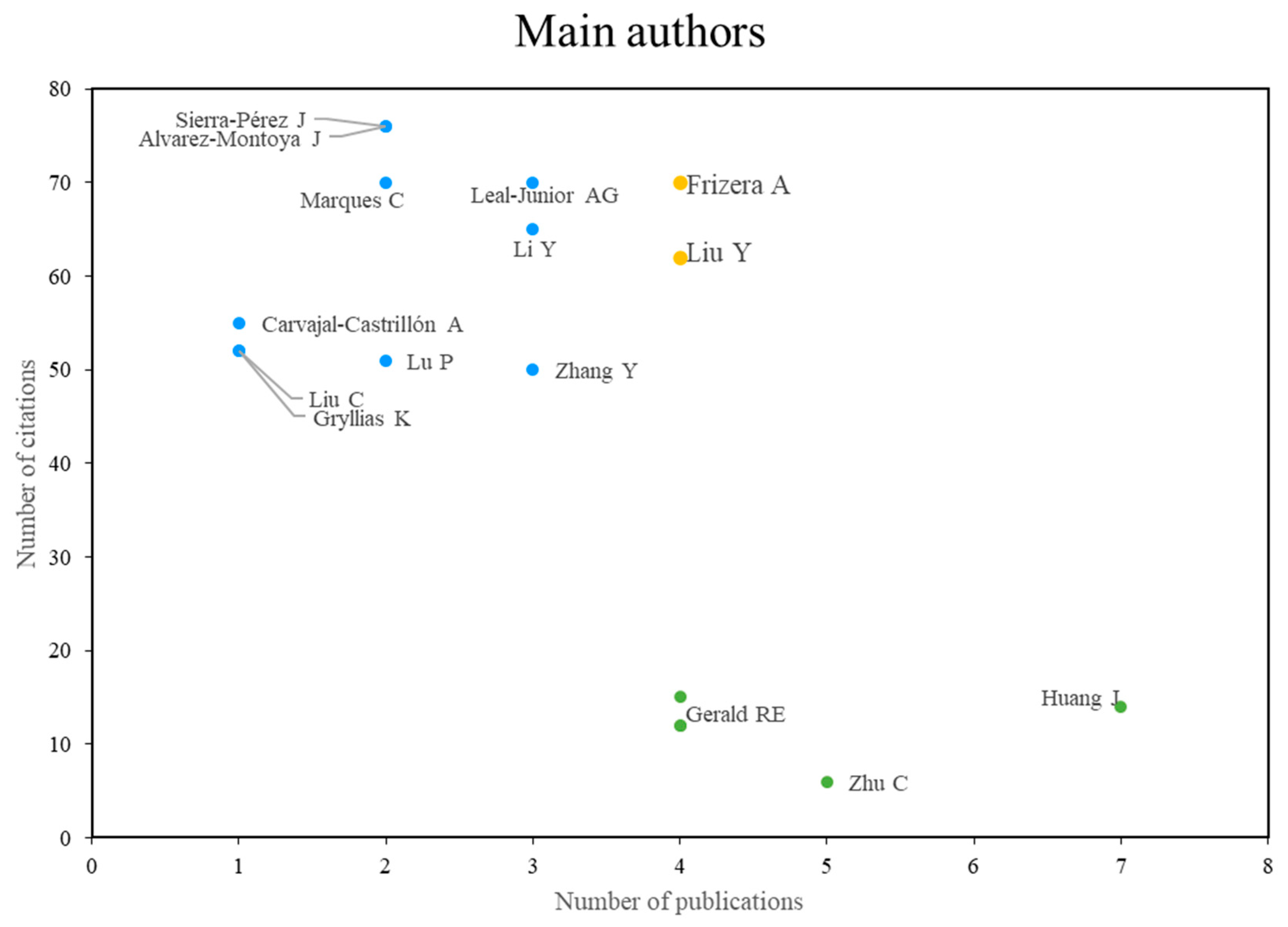
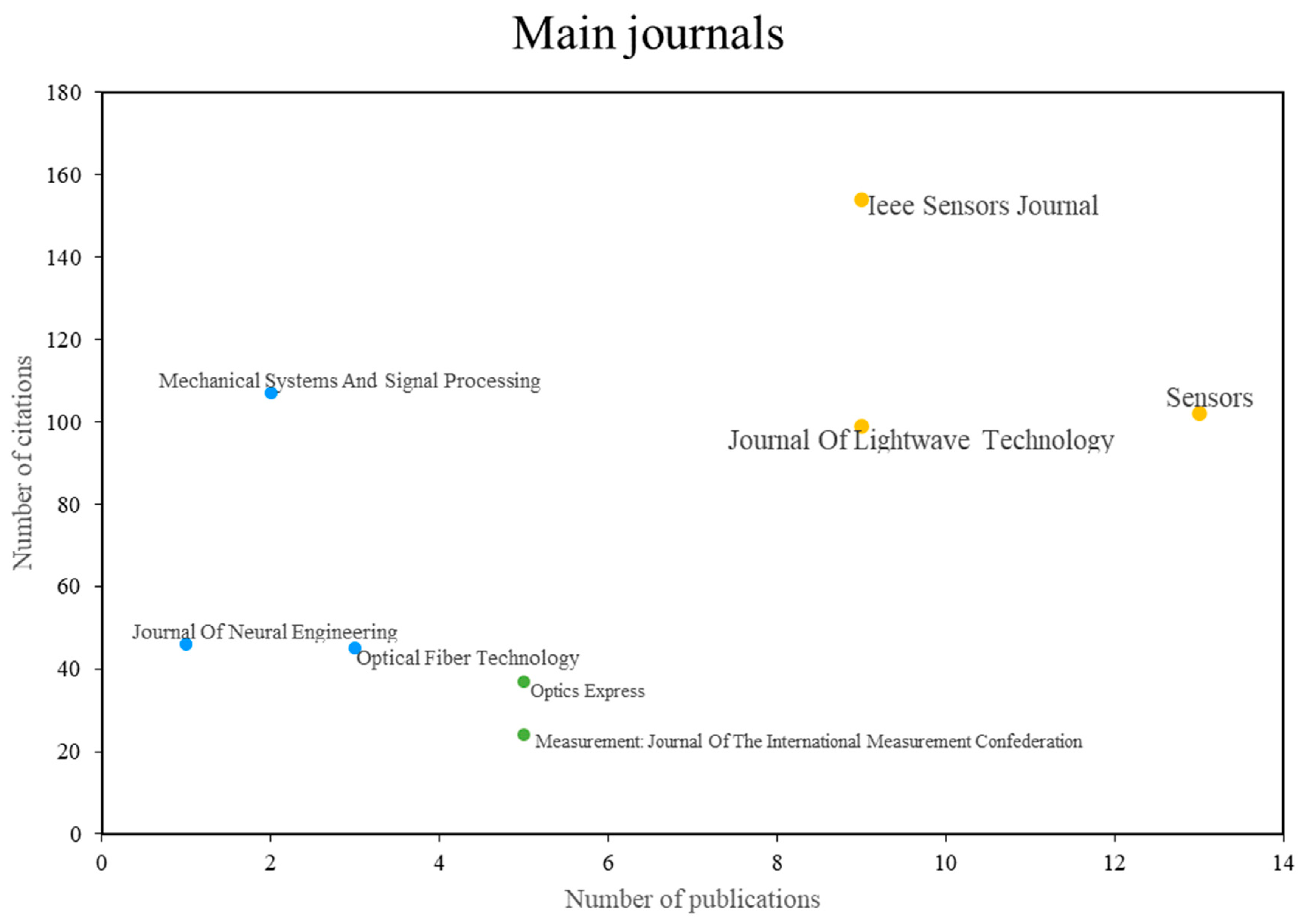
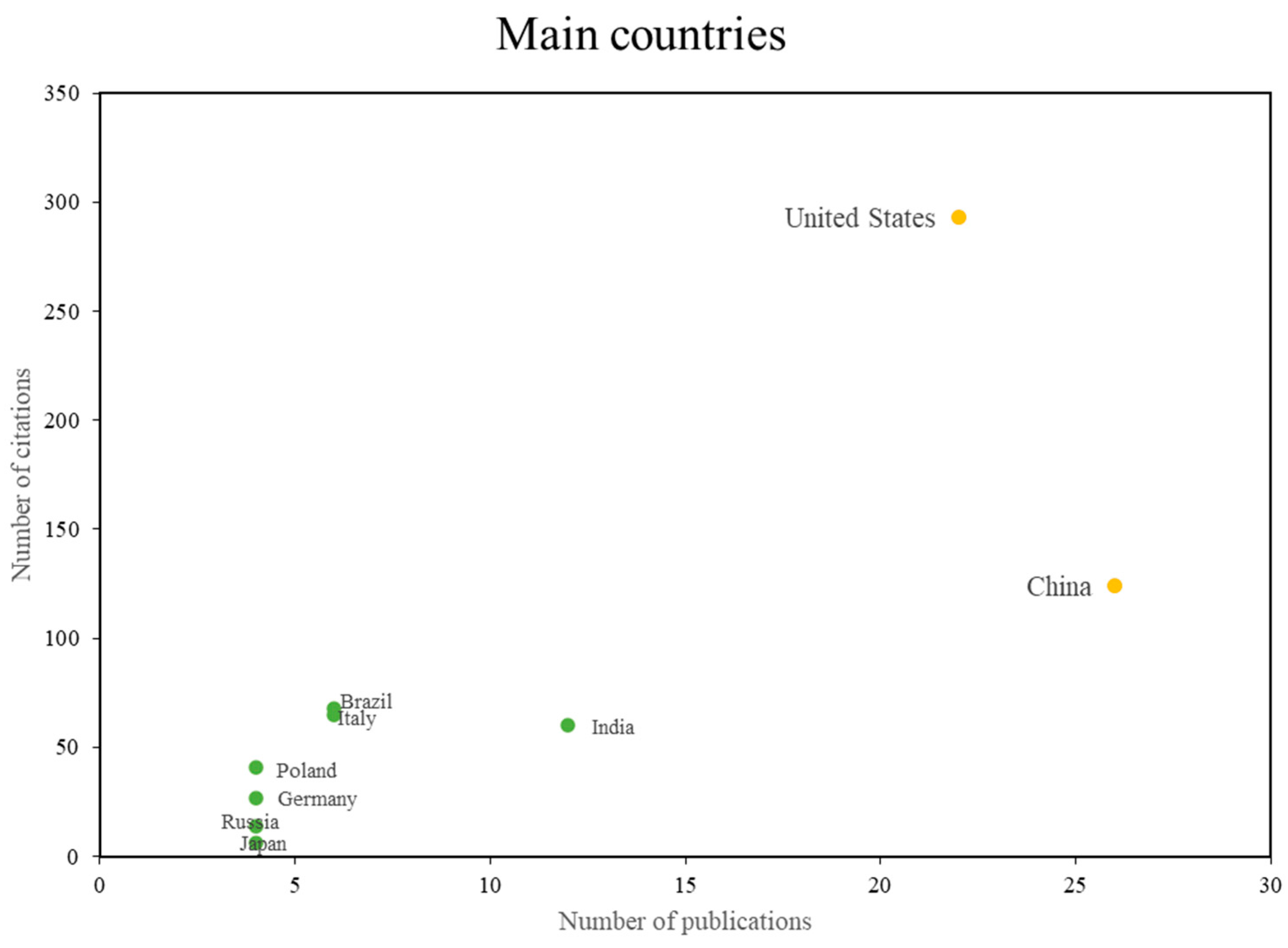
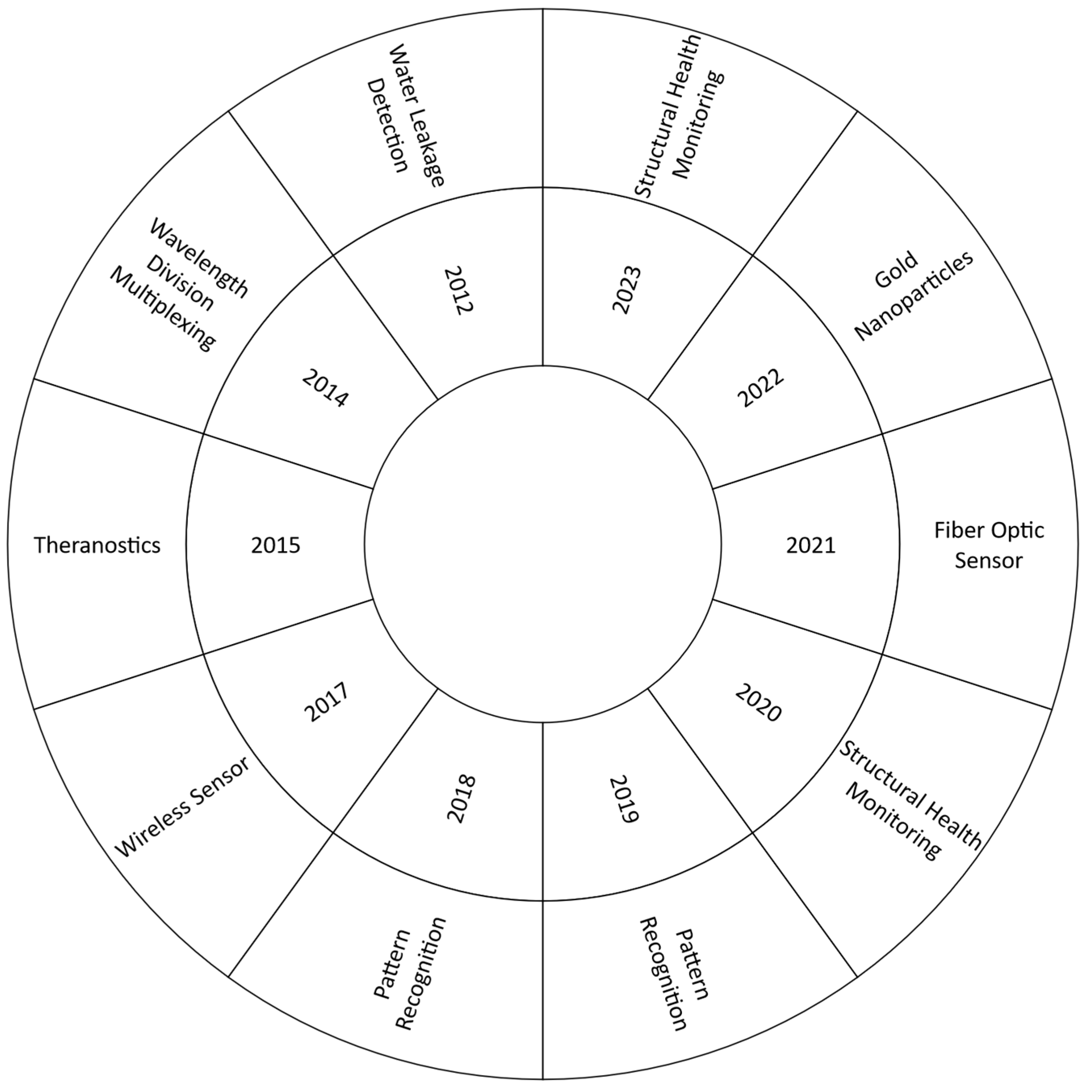
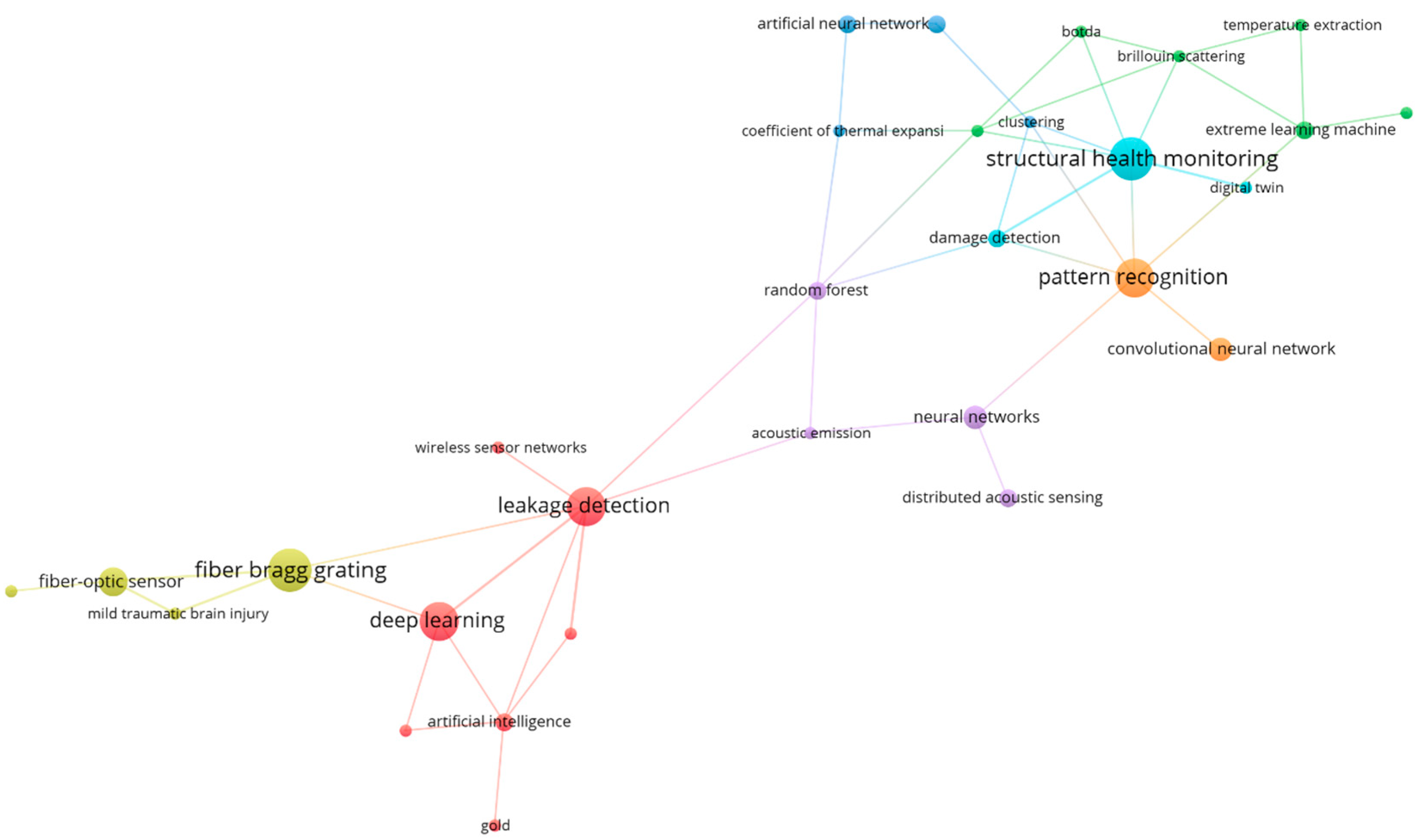

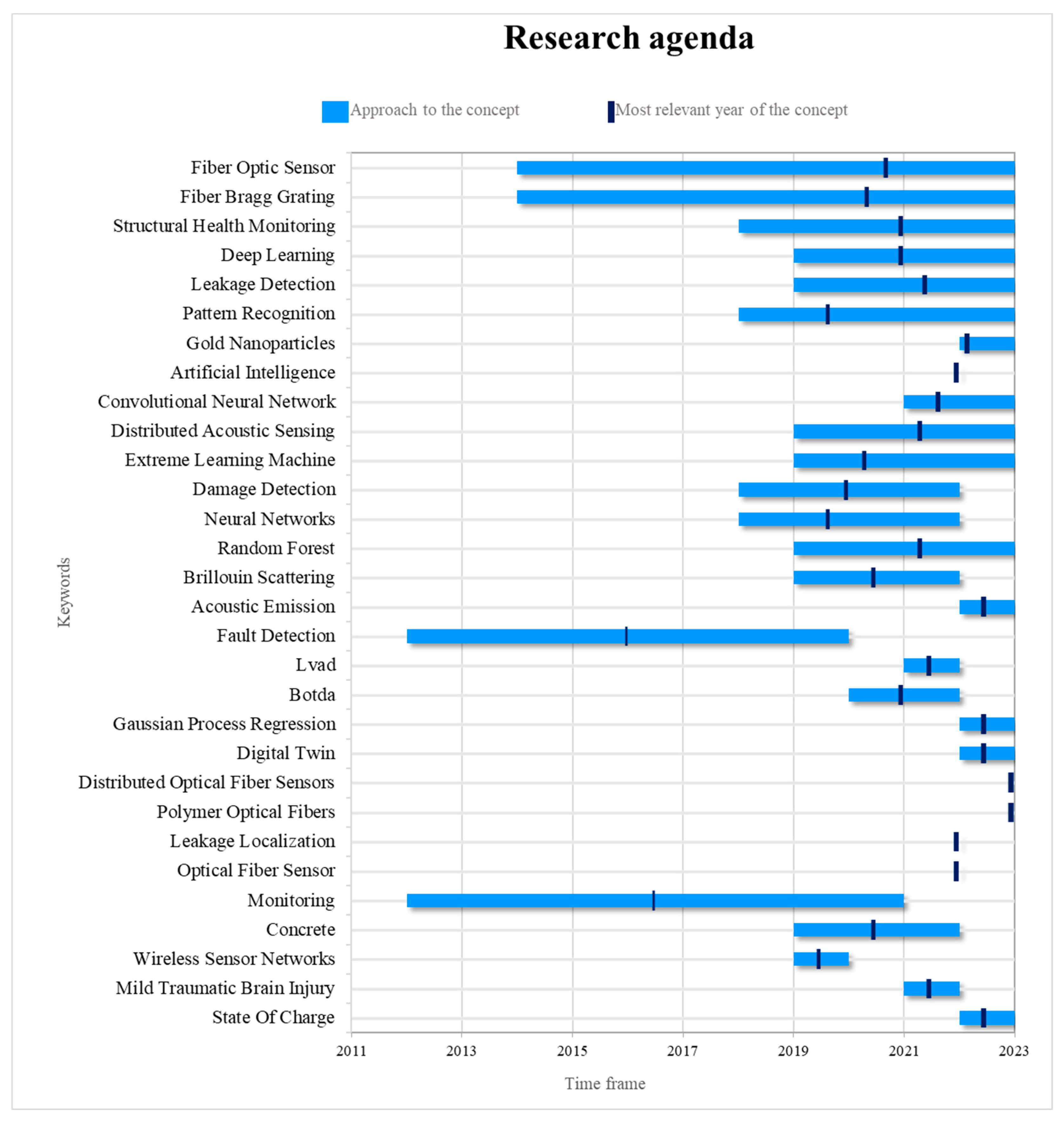
| Techniques | Tools | Applications | Characteristics |
|---|---|---|---|
| Deep Learning | Fiber Bragg Gratings | Leak detection | Temperature |
| Deep Learning Pattern Recognition | Distributed Fiber Optic Sensors | Structural Health Monitoring | Curvature |
| Convolutional Neural Networks | Data Analysis and Prediction | Left ventricular assist devices | Refractive Indicator |
| Artificial Neural Networks | Efecto Vernier | Crack prediction | Strain |
| Random forest | Fiber Specklegram Sensors | Mechanical and structural building failures | Acoustics/Vibrations |
| Predicting problems | Deformation |
Disclaimer/Publisher’s Note: The statements, opinions and data contained in all publications are solely those of the individual author(s) and contributor(s) and not of MDPI and/or the editor(s). MDPI and/or the editor(s) disclaim responsibility for any injury to people or property resulting from any ideas, methods, instructions or products referred to in the content. |
© 2024 by the authors. Licensee MDPI, Basel, Switzerland. This article is an open access article distributed under the terms and conditions of the Creative Commons Attribution (CC BY) license (https://creativecommons.org/licenses/by/4.0/).
Share and Cite
Reyes-Vera, E.; Valencia-Arias, A.; García-Pineda, V.; Aurora-Vigo, E.F.; Alvarez Vásquez, H.; Sánchez, G. Machine Learning Applications in Optical Fiber Sensing: A Research Agenda. Sensors 2024, 24, 2200. https://doi.org/10.3390/s24072200
Reyes-Vera E, Valencia-Arias A, García-Pineda V, Aurora-Vigo EF, Alvarez Vásquez H, Sánchez G. Machine Learning Applications in Optical Fiber Sensing: A Research Agenda. Sensors. 2024; 24(7):2200. https://doi.org/10.3390/s24072200
Chicago/Turabian StyleReyes-Vera, Erick, Alejandro Valencia-Arias, Vanessa García-Pineda, Edward Florencio Aurora-Vigo, Halyn Alvarez Vásquez, and Gustavo Sánchez. 2024. "Machine Learning Applications in Optical Fiber Sensing: A Research Agenda" Sensors 24, no. 7: 2200. https://doi.org/10.3390/s24072200
APA StyleReyes-Vera, E., Valencia-Arias, A., García-Pineda, V., Aurora-Vigo, E. F., Alvarez Vásquez, H., & Sánchez, G. (2024). Machine Learning Applications in Optical Fiber Sensing: A Research Agenda. Sensors, 24(7), 2200. https://doi.org/10.3390/s24072200









